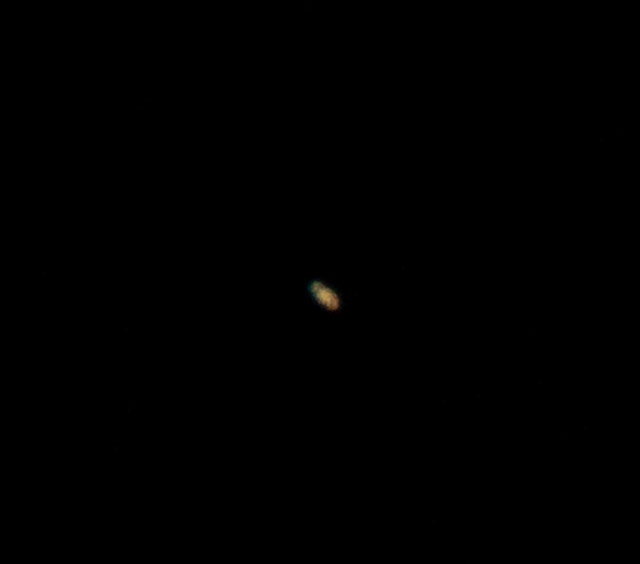Greetings from Palmia Observatory
Well, here we are again with another practice day of photographing Jupiter and Saturn as they approach the conjunction on December 21.
This photo shows Saturn, with visible rings, when the seeing would occasionally clear up enough, and Jupiter, with some visible moons.
 |
| Jupiter with moons and Saturn, DSLR, 600mm, 1/15 second (Source: Palmia Observatory) |
To see Saturn's rings more clearly needs a little more focal length. With the 600 mm telephoto and the DSLR set on magnify mode, the rings would often show up very clearly. But the planet is really zooming across the screen and you have to keep adjusting the position. If we were to use longer focal length, say 1200 or 2000 mm, we would really want to have the setup on a tracking mount. Anyway, if we blow up the image, above, we can see a fuzzy, elongated blob of light.
 | |
|
 | |
|
 |
| TWIV is a good source of weekly updates on virology (Source: www.microbe.tv/twiv) |
TWIV talked about the latest FDA approval of the Pfizer vaccine and the upcoming review and approval of the Moderna vaccine. They listed the documents submitted to the FDA approval, which are freely available for review. An example of one of the documents is posted below. So here we see some of the details about what goes into the vaccine.
 |
| Portion of FDA report on Moderna Emergency Use Authorization (Source: www.fda.gov) |
During the podcast I learned of two important numbers to keep in mind about the effectiveness of the vaccines. First, we have heard on the news and elsewhere that the effectiveness, which refers to how effective the vaccine is in preventing disease in inoculated people. So, the 94% effectiveness number means that out of a group of inoculated people, 94% do not get the disease. This is really good.
But there is another number in the reports that is a bit more worrisome. This is the number of inoculated people who will not be contagious and spread the virus to other people and this reported number is 60%. So, even though the vaccine is very effective at preventing you from getting sick, it is only 60% effective in preventing you, if you are infected and not showing any symptoms, from spreading it to others.
This worrisome fact takes some of the glow off the news of a vaccine! It means we will face some fear of still infecting others even if we ourselves are not sick or symptomatic and we will face more calls for constraint on our freedom. No one wants to intentionally infect someone else, but it seems we will be faced with that fact even with wide use of the vaccine.
Another fact about the vaccine that I found fascinating was the storage temperature for vaccines. I knew that many vaccines needed to be refrigerated, but the new reported storage temperatures are pretty interesting. The Pfizer vaccine needs to be stored at -70 C and the new Moderna vaccine gets by with storage of only -20 C. What about the vaccines require storage at such low temperatures.
Another topic that came up that I was especially interested in was a discussion of what is the risk associated with dining outdoors. Why are some states banning outdoor dining, which we had been led to believe was relatively safer than dining indoors? Well there is some data now showing up which tells us the relative risk difference between dining indoors and dining outdoors. This paper is taken from the references provided in the TWIV podcast.
So, dining outdoors is found to be about 18.7 times safer than dining indoors. That seems pretty good odds and can help all of us make an assessment for our own risk profile in making decisions.
 |
| Some recent data on inside and outside viral transmission (Source: Bulfone, et al, U. of Calif.) |
Ok, that is enough about vaccines. Let's consider going out and having some fun. We watched one of Josh Gate's "Josh Gates Tonight" episodes on TV and he described an adventure he went on with a company that offers airplane rides is a specially equipped airplane that simulates the zero-g environment for space flights. It looked like a lot of fun. You have probably seen videos of real astronauts going through training of this kind. So, the specially modified aircraft is configured like a big padded room (and maybe you should be locked up in a padded room if you want to go on this flight) and the aircraft goes through a series of parabolic climbs and descents. During the climbs you are pushed back against the floor with the equivalent gravity of about 1.8 g. During the descents, you are just about freely falling as if you were in the weightlessness of being in orbit.
So, doesn't this sound like fun? You can get close to the experience of being blasted into space and then experience the almost weightlessness of being in orbit. The flights occur from Long Beach and other cities and the next flight is on March 13, 2021 (and the 13th is not a Friday). Hmm, if we can't use the virus as an excuse not to go on that flight, hey, why not sign up and go for the experience? Ok, who's with me now to sign up?
 |
| Ok, space adventurers, let's sign up for zero-g experience (Source: www.gozerog.com) |
Until next time, here from our burrow, stay safe, as we recover more of our freedom,

No comments:
Post a Comment